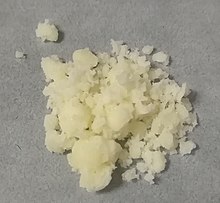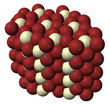| |||

| |||
| Names | |||
|---|---|---|---|
| Other names
terbium trichloride
| |||
| Identifiers | |||
3D model (JSmol)
|
|||
| ECHA InfoCard | 100.030.108 | ||
| EC Number |
| ||
PubChem CID
|
|||
| UNII | |||
CompTox Dashboard (EPA)
|
|||
| |||
| |||
| Properties | |||
| TbCl3 | |||
| Molar mass | 265.2834 g/mol | ||
| Appearance | white powder | ||
| Density | 4.35 g/cm3, solid | ||
| Melting point | 558 °C (1,036 °F; 831 K) | ||
| Boiling point | 180 to 200 °C (356 to 392 °F; 453 to 473 K) (in HCl gas atmosphere) | ||
| soluble | |||
| Structure | |||
| hexagonal (UCl3 type), hP8 | |||
| P63/m, No. 176 | |||
| Tricapped trigonal prismatic (nine-coordinate) | |||
| Hazards | |||
| GHS labelling:[1] | |||

| |||
| Warning | |||
| H315, H319 | |||
| P302+P352, P305+P351+P338 | |||
| Related compounds | |||
Other anions
|
Terbium(III) oxide | ||
Other cations
|
Gadolinium(III) chloride Dysprosium(III) chloride | ||
Except where otherwise noted, data are given for materials in their standard state (at 25 °C [77 °F], 100 kPa).
| |||
Terbium(III) chloride (TbCl3) is a chemical compound. In the solid state TbCl3 has the YCl3 layer structure.[2] Terbium(III) chloride frequently forms a hexahydrate.
- ^ GHS: Sigma-Alderich 204560
- ^ Wells A.F. (1984) Structural Inorganic Chemistry 5th edition Oxford Science Publications ISBN 0-19-855370-6

